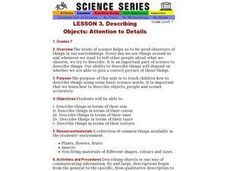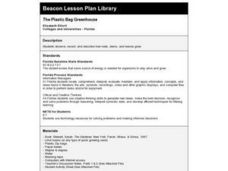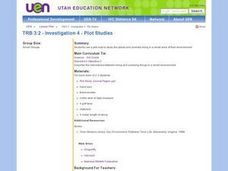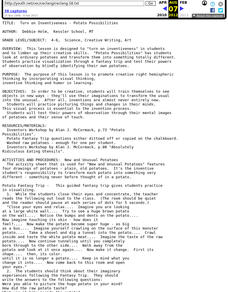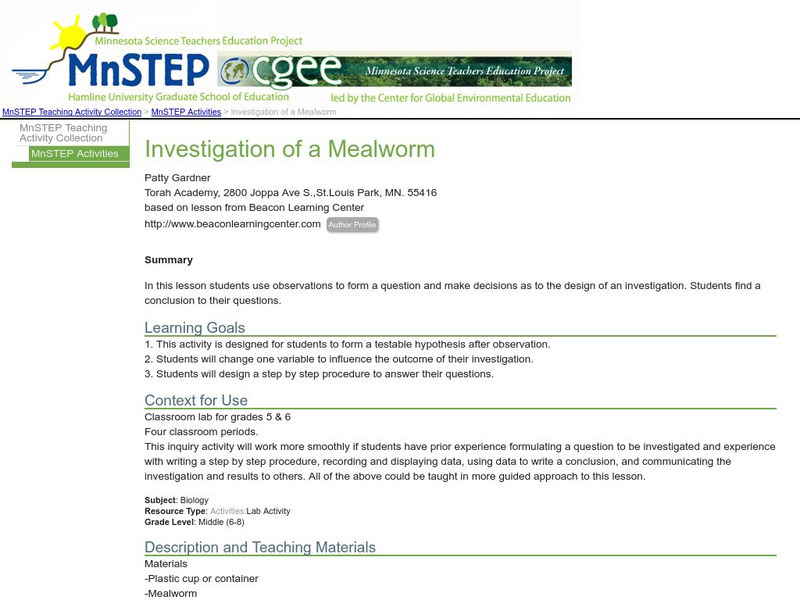Curated OER
Fossils
First graders write a brief informational description of a real life object, person, place or event using information gained from observations. They create their own fossil imprints and write a brief description about the fossil that...
Curated OER
Graphing Sound
Students formulate an understanding of sound as a vibration and draw their graph as carefully as possible on their observation sheet. They also record how they made the sound and and a description of the sound. Finally, students cut out...
Curated OER
Scientific Method for Middle Schools
Students use the scientific method to solve a teacher scenario. They bring in M&M's. Students are given a copy of the scientific method. They first come up with a problem. Students are told that they are going to conduct an...
Curated OER
Fossil Evidence
Students evaluate each other's fossil imprints and they try to identify the original object. They comprehend the importance of accuracy in identifying a fossil imprint. Students create an answer sheet that has space for the names of the...
Curated OER
Birds and Birdfeed
Fourth graders examine the basic survival needs of birds before examining a suet ball as an example of what birds eat. They conduct an experiment with pine cones, bird seed, vaseline, and peanut butter. By observing the birds, they...
Curated OER
Shapes, Shapes Everywhere!
Sixth graders investigate the geometric concept of shapes. They locate shapes in their immediate environment and label them according to basic shape. The shapes that are found are recorded by the teacher on chart paper and any...
Curated OER
Rock Art
Students create replica symbols of rock are found in Wisconsin and work cooperatively to create a rock art panel. They observe rock art to find their meanings and reasons why they were created.
Curated OER
The Sum of the Parts
Second graders observe some everyday common objects in order to attempt to learn about simple systems and how they fit together. They observe small details in order to identify the parts of a whole design.
Curated OER
Making Sense of Unusual Findings
Students work on the development of observation skills and seeing how they can be used in different contexts. The lesson is good for helping the beginner and novice, along with encouraging and reminding the expert observer of right...
Curated OER
Wig-wag Physics
Young scholars make observations on the effects of a small, medium and large weight on the movement of a wig-wag apparatus. They use their observations to develop a generalized inference of the effect weight on movement patterns.
Curated OER
Rain Drops
Students examine drops of water on several materials used on the outside of buildings. They make selective observations on and compare plastic, wood, brick, metal, roof tiles and glass.
Curated OER
Observation
Young scholars practice observation skills by discussing physical attributes of family artifacts. They determine what characteristics of an object are considered important details.
Curated OER
Physical Properties of Ice
Students demonstrate that ice melts faster under pressure. They recognize that ice can be broken up or melted by pressure and then refreeze.
Curated OER
Charting the Moon
Sixth graders observe changes in the moon's appearance over a month and keep records of their observations. They write a plan for recording what they see, and a paragraph reflecting on what they have learned over the course of the month.
Curated OER
Describing Objects: Attention to Details
Seventh graders study how observation and accurate descriptions are an important in science. They use basic science words in their descriptions.
Curated OER
Chameleons
Young scholars read "The Mixed-Up Chameleon" by Eric Carle. They discuss the chameleon's color changes and their ability to catch flies. They read a fact sheet. They view a live chameleon in a natural environment. They write down...
Curated OER
The Plastic Bag Greenhouse
Third graders observe plants and record their growth. They describe the parts of plants in detail including the roots, stems and leaves.
Curated OER
Investigation 4 - Plot Studies
Third graders use a plot map to study the plants and animals living in a small area of their environment.
Curated OER
Carbons to Computers - 1
Students gather and classify information from observation of photographs; to have students differentiate between fact and inference.
Curated OER
Turn on Inventiveness
Students practice visualization through a fantasy trip and test their powers of observation by blindly identifying their own potatoes.
City University of New York
Scientific Method and Probability: Interactive Activity
This interactive lesson begins with the basics and carries through to methods of data analysis, all interactively. Supporting material is excellent.
Science Education Resource Center at Carleton College
Serc: Investigation of a Mealworm
A lab activity where students make observations about mealworms to form questions and decide what direction their investigation will take. While studying mealworms, students will choose a variable to change to observe changes to the...
Science Education Resource Center at Carleton College
Serc: Investigating Oranges How Many Sections Are Inside?
For this biology investigation students will be asked to attempt to determine how many sections exist in an orange without having peeled it. Students will work in small cooperative groups. Each group will be able to use a small...
Science Education Resource Center at Carleton College
Serc: Investigating South Crow River: Discharge, Turbidity, Erosion, Sediments
In this field investigation, small groups of students will observe and measure characteristics of the South Crow River near Mayer, Minnesota. Data collection on these characteristics will include but not be limited to: speed of current...
















